Biology Investigation: Personality Modulation of Stress Responses
VerifiedAdded on 2023/06/11
|11
|2298
|174
Report
AI Summary
This biology report investigates the relationship between personality types (Type A and Type B) and stress responses, focusing on pulse rate as a measure of stress. The study employs the Friedman and Rosenman questionnaire to categorize participants and the Stroop Color Word Test to induce stress. Pulse rates were measured during the stress task, and the data was analyzed using an independent sample t-test. The results indicated a statistically significant difference in pulse rates between Type A and Type B individuals, with Type A personalities exhibiting higher pulse rates during stress. The study concludes that personality significantly modulates an individual's stress response, highlighting the physiological differences between personality types. The appendices include raw data tables.
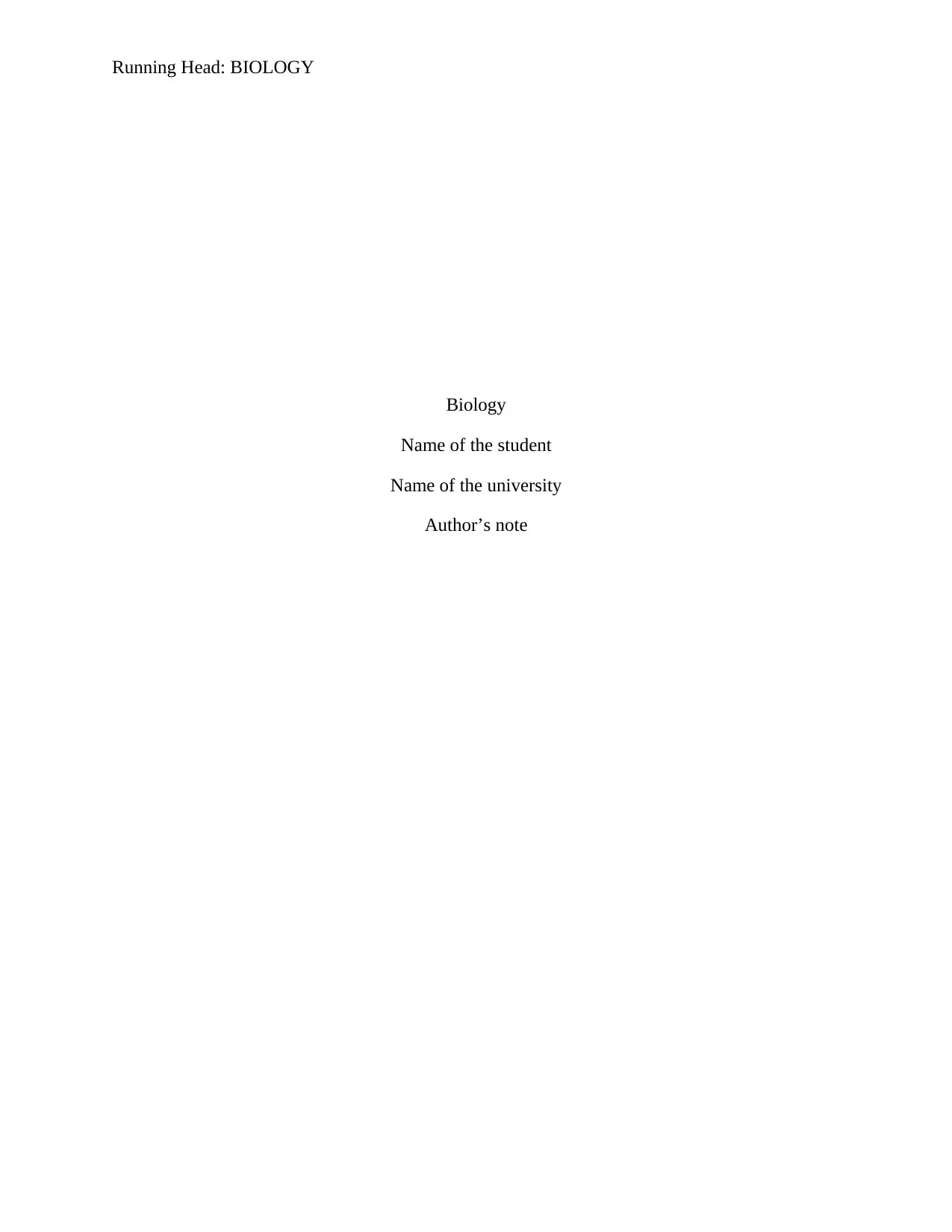
Running Head: BIOLOGY
Biology
Name of the student
Name of the university
Author’s note
Biology
Name of the student
Name of the university
Author’s note
Paraphrase This Document
Need a fresh take? Get an instant paraphrase of this document with our AI Paraphraser
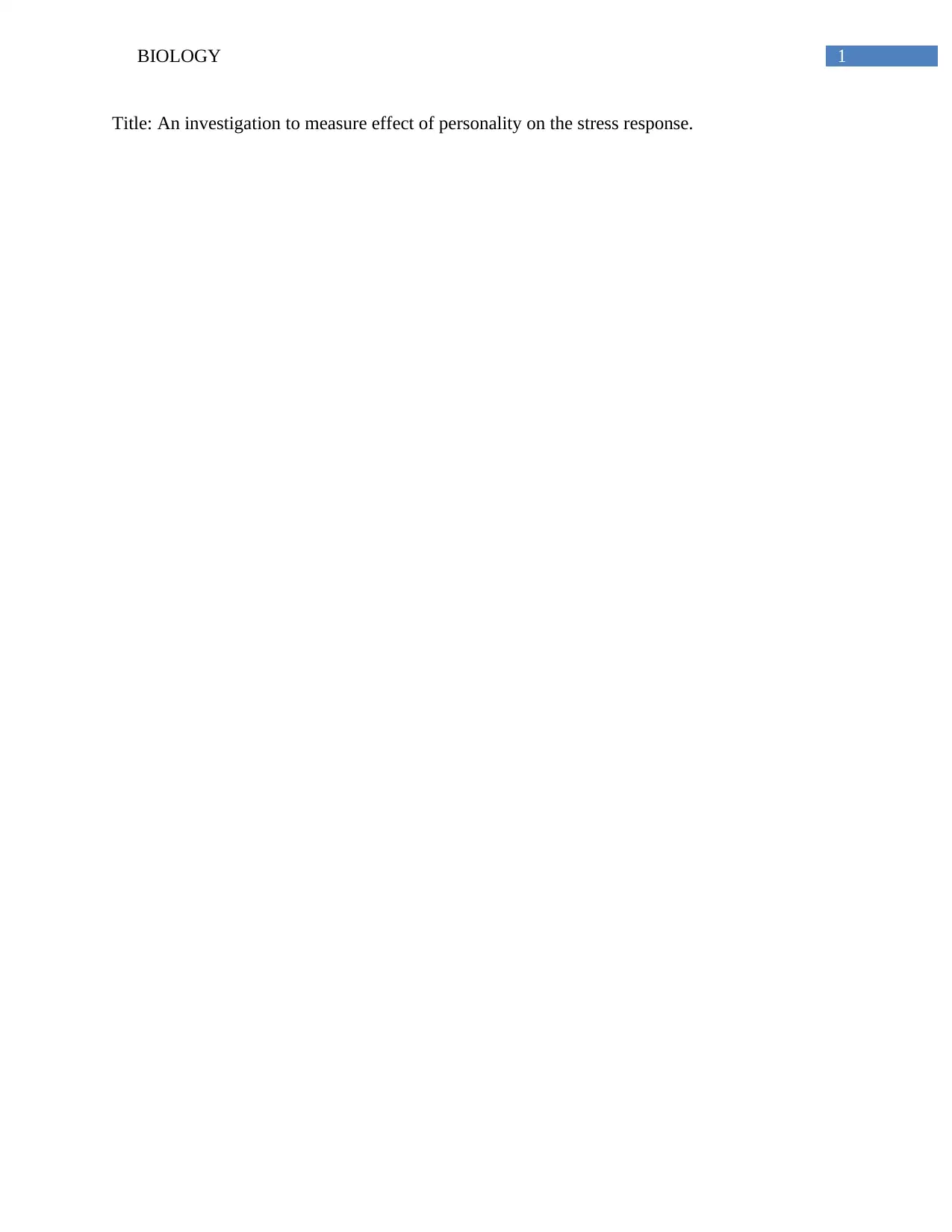
1BIOLOGY
Title: An investigation to measure effect of personality on the stress response.
Title: An investigation to measure effect of personality on the stress response.
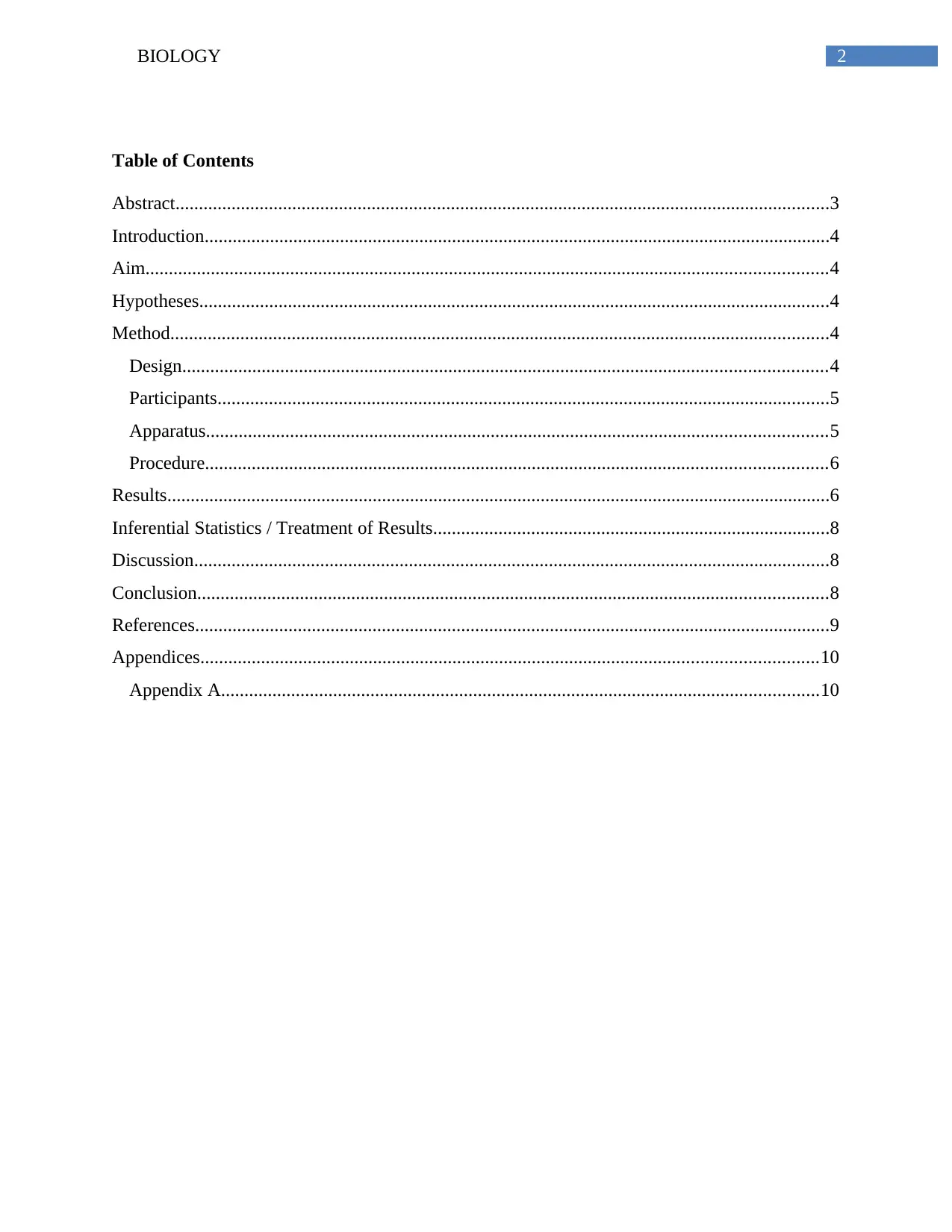
2BIOLOGY
Table of Contents
Abstract............................................................................................................................................3
Introduction......................................................................................................................................4
Aim..................................................................................................................................................4
Hypotheses.......................................................................................................................................4
Method.............................................................................................................................................4
Design..........................................................................................................................................4
Participants...................................................................................................................................5
Apparatus.....................................................................................................................................5
Procedure.....................................................................................................................................6
Results..............................................................................................................................................6
Inferential Statistics / Treatment of Results.....................................................................................8
Discussion........................................................................................................................................8
Conclusion.......................................................................................................................................8
References........................................................................................................................................9
Appendices....................................................................................................................................10
Appendix A................................................................................................................................10
Table of Contents
Abstract............................................................................................................................................3
Introduction......................................................................................................................................4
Aim..................................................................................................................................................4
Hypotheses.......................................................................................................................................4
Method.............................................................................................................................................4
Design..........................................................................................................................................4
Participants...................................................................................................................................5
Apparatus.....................................................................................................................................5
Procedure.....................................................................................................................................6
Results..............................................................................................................................................6
Inferential Statistics / Treatment of Results.....................................................................................8
Discussion........................................................................................................................................8
Conclusion.......................................................................................................................................8
References........................................................................................................................................9
Appendices....................................................................................................................................10
Appendix A................................................................................................................................10
⊘ This is a preview!⊘
Do you want full access?
Subscribe today to unlock all pages.

Trusted by 1+ million students worldwide
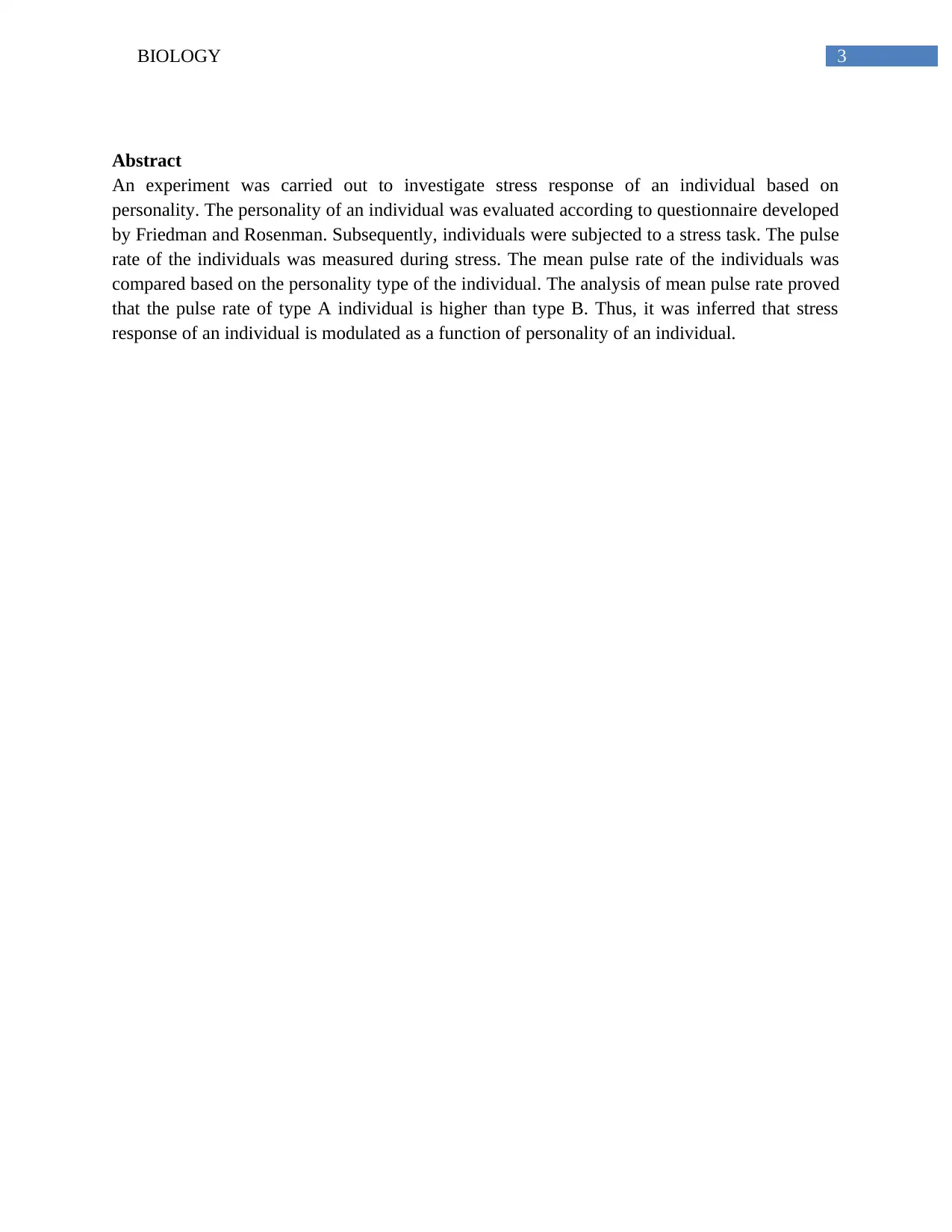
3BIOLOGY
Abstract
An experiment was carried out to investigate stress response of an individual based on
personality. The personality of an individual was evaluated according to questionnaire developed
by Friedman and Rosenman. Subsequently, individuals were subjected to a stress task. The pulse
rate of the individuals was measured during stress. The mean pulse rate of the individuals was
compared based on the personality type of the individual. The analysis of mean pulse rate proved
that the pulse rate of type A individual is higher than type B. Thus, it was inferred that stress
response of an individual is modulated as a function of personality of an individual.
Abstract
An experiment was carried out to investigate stress response of an individual based on
personality. The personality of an individual was evaluated according to questionnaire developed
by Friedman and Rosenman. Subsequently, individuals were subjected to a stress task. The pulse
rate of the individuals was measured during stress. The mean pulse rate of the individuals was
compared based on the personality type of the individual. The analysis of mean pulse rate proved
that the pulse rate of type A individual is higher than type B. Thus, it was inferred that stress
response of an individual is modulated as a function of personality of an individual.
Paraphrase This Document
Need a fresh take? Get an instant paraphrase of this document with our AI Paraphraser
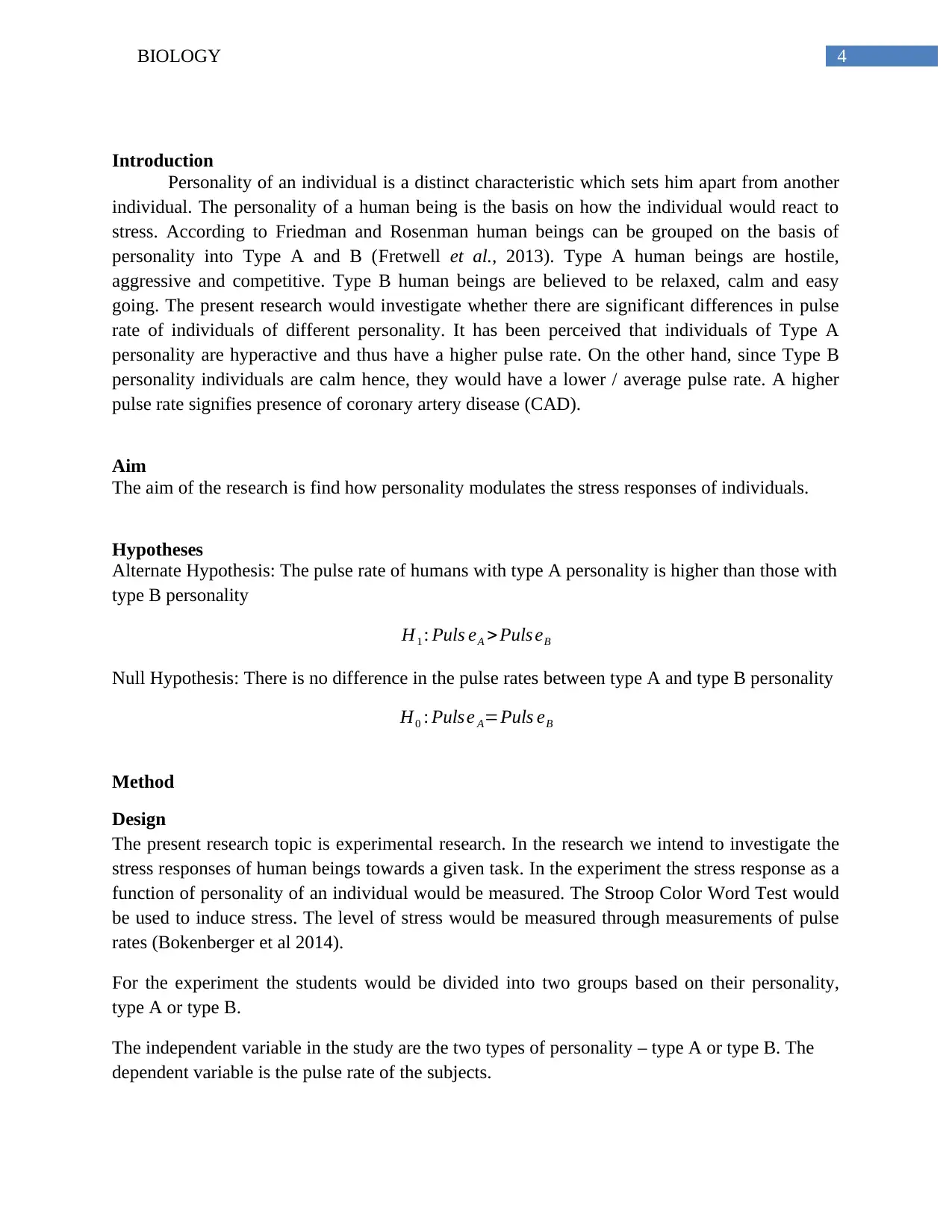
4BIOLOGY
Introduction
Personality of an individual is a distinct characteristic which sets him apart from another
individual. The personality of a human being is the basis on how the individual would react to
stress. According to Friedman and Rosenman human beings can be grouped on the basis of
personality into Type A and B (Fretwell et al., 2013). Type A human beings are hostile,
aggressive and competitive. Type B human beings are believed to be relaxed, calm and easy
going. The present research would investigate whether there are significant differences in pulse
rate of individuals of different personality. It has been perceived that individuals of Type A
personality are hyperactive and thus have a higher pulse rate. On the other hand, since Type B
personality individuals are calm hence, they would have a lower / average pulse rate. A higher
pulse rate signifies presence of coronary artery disease (CAD).
Aim
The aim of the research is find how personality modulates the stress responses of individuals.
Hypotheses
Alternate Hypothesis: The pulse rate of humans with type A personality is higher than those with
type B personality
H1 : Puls eA > Puls eB
Null Hypothesis: There is no difference in the pulse rates between type A and type B personality
H0 : Puls e A=Puls eB
Method
Design
The present research topic is experimental research. In the research we intend to investigate the
stress responses of human beings towards a given task. In the experiment the stress response as a
function of personality of an individual would be measured. The Stroop Color Word Test would
be used to induce stress. The level of stress would be measured through measurements of pulse
rates (Bokenberger et al 2014).
For the experiment the students would be divided into two groups based on their personality,
type A or type B.
The independent variable in the study are the two types of personality – type A or type B. The
dependent variable is the pulse rate of the subjects.
Introduction
Personality of an individual is a distinct characteristic which sets him apart from another
individual. The personality of a human being is the basis on how the individual would react to
stress. According to Friedman and Rosenman human beings can be grouped on the basis of
personality into Type A and B (Fretwell et al., 2013). Type A human beings are hostile,
aggressive and competitive. Type B human beings are believed to be relaxed, calm and easy
going. The present research would investigate whether there are significant differences in pulse
rate of individuals of different personality. It has been perceived that individuals of Type A
personality are hyperactive and thus have a higher pulse rate. On the other hand, since Type B
personality individuals are calm hence, they would have a lower / average pulse rate. A higher
pulse rate signifies presence of coronary artery disease (CAD).
Aim
The aim of the research is find how personality modulates the stress responses of individuals.
Hypotheses
Alternate Hypothesis: The pulse rate of humans with type A personality is higher than those with
type B personality
H1 : Puls eA > Puls eB
Null Hypothesis: There is no difference in the pulse rates between type A and type B personality
H0 : Puls e A=Puls eB
Method
Design
The present research topic is experimental research. In the research we intend to investigate the
stress responses of human beings towards a given task. In the experiment the stress response as a
function of personality of an individual would be measured. The Stroop Color Word Test would
be used to induce stress. The level of stress would be measured through measurements of pulse
rates (Bokenberger et al 2014).
For the experiment the students would be divided into two groups based on their personality,
type A or type B.
The independent variable in the study are the two types of personality – type A or type B. The
dependent variable is the pulse rate of the subjects.
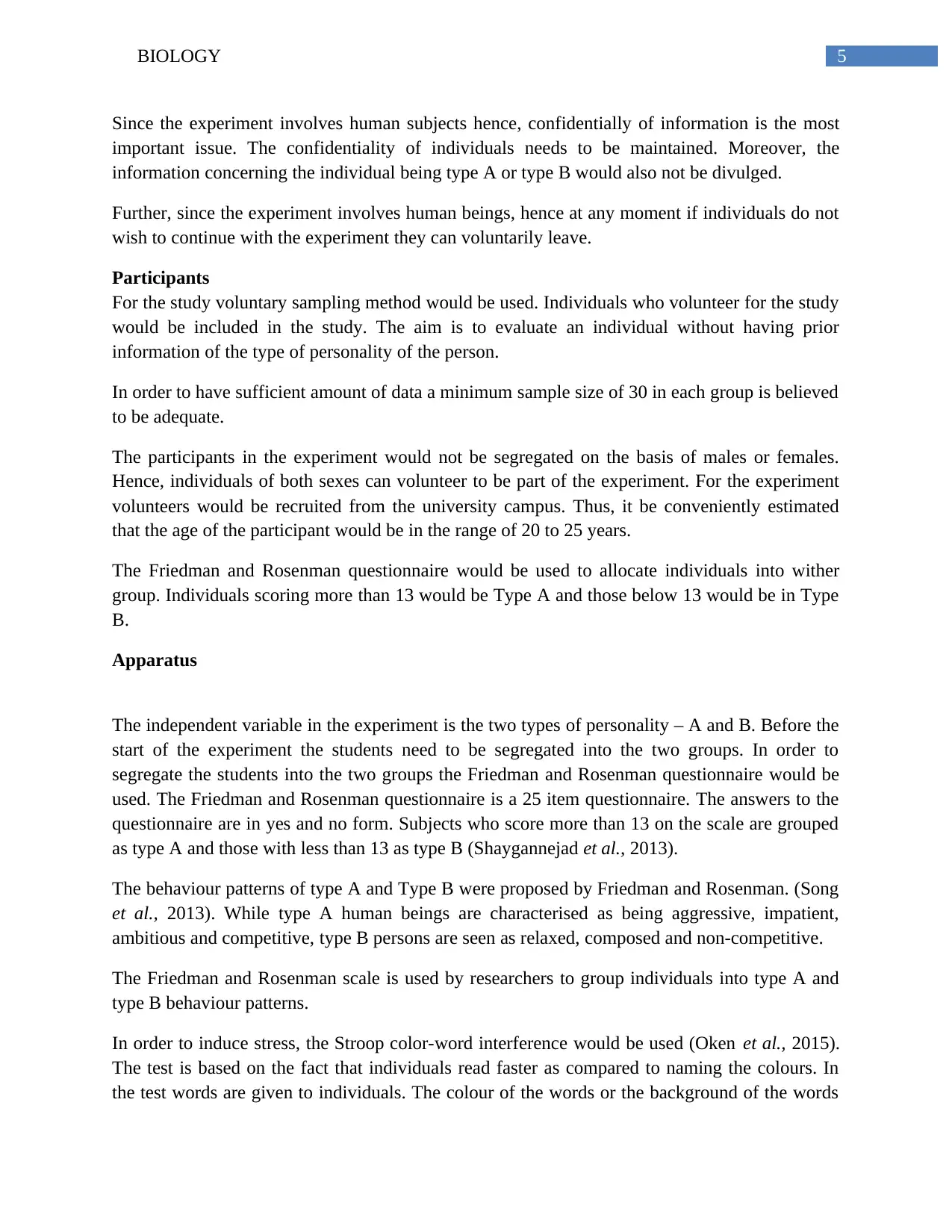
5BIOLOGY
Since the experiment involves human subjects hence, confidentially of information is the most
important issue. The confidentiality of individuals needs to be maintained. Moreover, the
information concerning the individual being type A or type B would also not be divulged.
Further, since the experiment involves human beings, hence at any moment if individuals do not
wish to continue with the experiment they can voluntarily leave.
Participants
For the study voluntary sampling method would be used. Individuals who volunteer for the study
would be included in the study. The aim is to evaluate an individual without having prior
information of the type of personality of the person.
In order to have sufficient amount of data a minimum sample size of 30 in each group is believed
to be adequate.
The participants in the experiment would not be segregated on the basis of males or females.
Hence, individuals of both sexes can volunteer to be part of the experiment. For the experiment
volunteers would be recruited from the university campus. Thus, it be conveniently estimated
that the age of the participant would be in the range of 20 to 25 years.
The Friedman and Rosenman questionnaire would be used to allocate individuals into wither
group. Individuals scoring more than 13 would be Type A and those below 13 would be in Type
B.
Apparatus
The independent variable in the experiment is the two types of personality – A and B. Before the
start of the experiment the students need to be segregated into the two groups. In order to
segregate the students into the two groups the Friedman and Rosenman questionnaire would be
used. The Friedman and Rosenman questionnaire is a 25 item questionnaire. The answers to the
questionnaire are in yes and no form. Subjects who score more than 13 on the scale are grouped
as type A and those with less than 13 as type B (Shaygannejad et al., 2013).
The behaviour patterns of type A and Type B were proposed by Friedman and Rosenman. (Song
et al., 2013). While type A human beings are characterised as being aggressive, impatient,
ambitious and competitive, type B persons are seen as relaxed, composed and non-competitive.
The Friedman and Rosenman scale is used by researchers to group individuals into type A and
type B behaviour patterns.
In order to induce stress, the Stroop color-word interference would be used (Oken et al., 2015).
The test is based on the fact that individuals read faster as compared to naming the colours. In
the test words are given to individuals. The colour of the words or the background of the words
Since the experiment involves human subjects hence, confidentially of information is the most
important issue. The confidentiality of individuals needs to be maintained. Moreover, the
information concerning the individual being type A or type B would also not be divulged.
Further, since the experiment involves human beings, hence at any moment if individuals do not
wish to continue with the experiment they can voluntarily leave.
Participants
For the study voluntary sampling method would be used. Individuals who volunteer for the study
would be included in the study. The aim is to evaluate an individual without having prior
information of the type of personality of the person.
In order to have sufficient amount of data a minimum sample size of 30 in each group is believed
to be adequate.
The participants in the experiment would not be segregated on the basis of males or females.
Hence, individuals of both sexes can volunteer to be part of the experiment. For the experiment
volunteers would be recruited from the university campus. Thus, it be conveniently estimated
that the age of the participant would be in the range of 20 to 25 years.
The Friedman and Rosenman questionnaire would be used to allocate individuals into wither
group. Individuals scoring more than 13 would be Type A and those below 13 would be in Type
B.
Apparatus
The independent variable in the experiment is the two types of personality – A and B. Before the
start of the experiment the students need to be segregated into the two groups. In order to
segregate the students into the two groups the Friedman and Rosenman questionnaire would be
used. The Friedman and Rosenman questionnaire is a 25 item questionnaire. The answers to the
questionnaire are in yes and no form. Subjects who score more than 13 on the scale are grouped
as type A and those with less than 13 as type B (Shaygannejad et al., 2013).
The behaviour patterns of type A and Type B were proposed by Friedman and Rosenman. (Song
et al., 2013). While type A human beings are characterised as being aggressive, impatient,
ambitious and competitive, type B persons are seen as relaxed, composed and non-competitive.
The Friedman and Rosenman scale is used by researchers to group individuals into type A and
type B behaviour patterns.
In order to induce stress, the Stroop color-word interference would be used (Oken et al., 2015).
The test is based on the fact that individuals read faster as compared to naming the colours. In
the test words are given to individuals. The colour of the words or the background of the words
⊘ This is a preview!⊘
Do you want full access?
Subscribe today to unlock all pages.

Trusted by 1+ million students worldwide
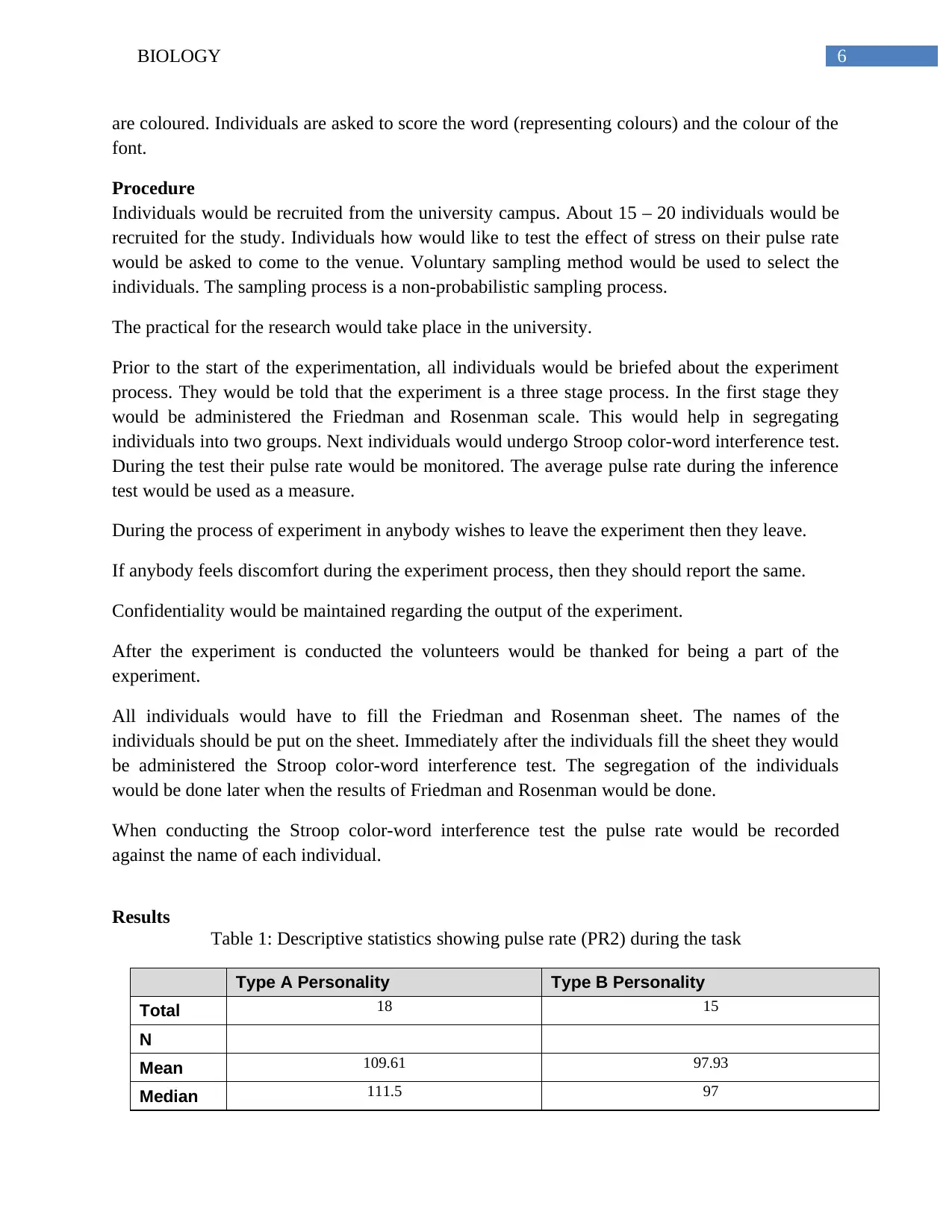
6BIOLOGY
are coloured. Individuals are asked to score the word (representing colours) and the colour of the
font.
Procedure
Individuals would be recruited from the university campus. About 15 – 20 individuals would be
recruited for the study. Individuals how would like to test the effect of stress on their pulse rate
would be asked to come to the venue. Voluntary sampling method would be used to select the
individuals. The sampling process is a non-probabilistic sampling process.
The practical for the research would take place in the university.
Prior to the start of the experimentation, all individuals would be briefed about the experiment
process. They would be told that the experiment is a three stage process. In the first stage they
would be administered the Friedman and Rosenman scale. This would help in segregating
individuals into two groups. Next individuals would undergo Stroop color-word interference test.
During the test their pulse rate would be monitored. The average pulse rate during the inference
test would be used as a measure.
During the process of experiment in anybody wishes to leave the experiment then they leave.
If anybody feels discomfort during the experiment process, then they should report the same.
Confidentiality would be maintained regarding the output of the experiment.
After the experiment is conducted the volunteers would be thanked for being a part of the
experiment.
All individuals would have to fill the Friedman and Rosenman sheet. The names of the
individuals should be put on the sheet. Immediately after the individuals fill the sheet they would
be administered the Stroop color-word interference test. The segregation of the individuals
would be done later when the results of Friedman and Rosenman would be done.
When conducting the Stroop color-word interference test the pulse rate would be recorded
against the name of each individual.
Results
Table 1: Descriptive statistics showing pulse rate (PR2) during the task
Type A Personality Type B Personality
Total 18 15
N
Mean 109.61 97.93
Median 111.5 97
are coloured. Individuals are asked to score the word (representing colours) and the colour of the
font.
Procedure
Individuals would be recruited from the university campus. About 15 – 20 individuals would be
recruited for the study. Individuals how would like to test the effect of stress on their pulse rate
would be asked to come to the venue. Voluntary sampling method would be used to select the
individuals. The sampling process is a non-probabilistic sampling process.
The practical for the research would take place in the university.
Prior to the start of the experimentation, all individuals would be briefed about the experiment
process. They would be told that the experiment is a three stage process. In the first stage they
would be administered the Friedman and Rosenman scale. This would help in segregating
individuals into two groups. Next individuals would undergo Stroop color-word interference test.
During the test their pulse rate would be monitored. The average pulse rate during the inference
test would be used as a measure.
During the process of experiment in anybody wishes to leave the experiment then they leave.
If anybody feels discomfort during the experiment process, then they should report the same.
Confidentiality would be maintained regarding the output of the experiment.
After the experiment is conducted the volunteers would be thanked for being a part of the
experiment.
All individuals would have to fill the Friedman and Rosenman sheet. The names of the
individuals should be put on the sheet. Immediately after the individuals fill the sheet they would
be administered the Stroop color-word interference test. The segregation of the individuals
would be done later when the results of Friedman and Rosenman would be done.
When conducting the Stroop color-word interference test the pulse rate would be recorded
against the name of each individual.
Results
Table 1: Descriptive statistics showing pulse rate (PR2) during the task
Type A Personality Type B Personality
Total 18 15
N
Mean 109.61 97.93
Median 111.5 97
Paraphrase This Document
Need a fresh take? Get an instant paraphrase of this document with our AI Paraphraser
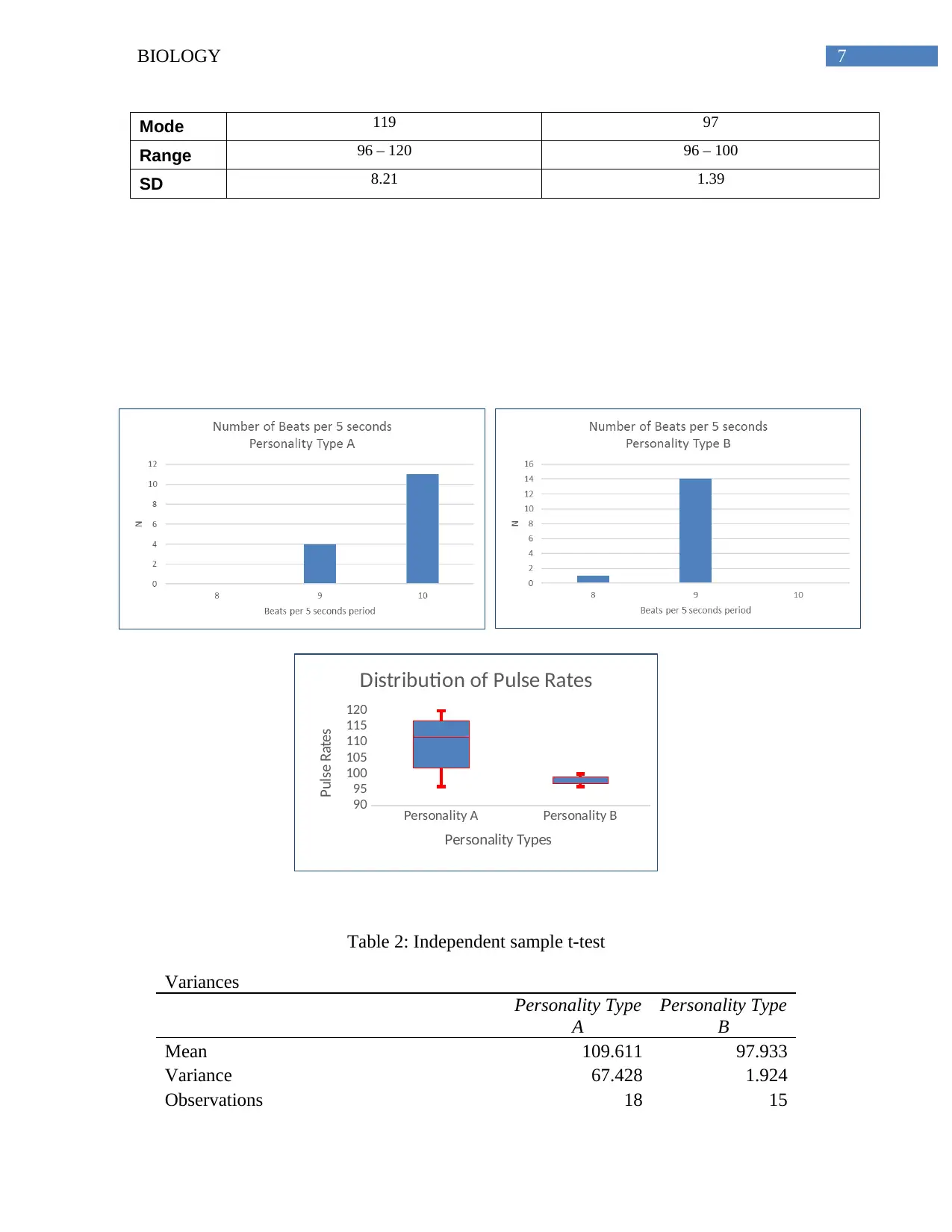
7BIOLOGY
Mode 119 97
Range 96 – 120 96 – 100
SD 8.21 1.39
Personality A Personality B
90
95
100
105
110
115
120
Distribution of Pulse Rates
Personality Types
Pulse Rates
Table 2: Independent sample t-test
Variances
Personality Type
A
Personality Type
B
Mean 109.611 97.933
Variance 67.428 1.924
Observations 18 15
Mode 119 97
Range 96 – 120 96 – 100
SD 8.21 1.39
Personality A Personality B
90
95
100
105
110
115
120
Distribution of Pulse Rates
Personality Types
Pulse Rates
Table 2: Independent sample t-test
Variances
Personality Type
A
Personality Type
B
Mean 109.611 97.933
Variance 67.428 1.924
Observations 18 15
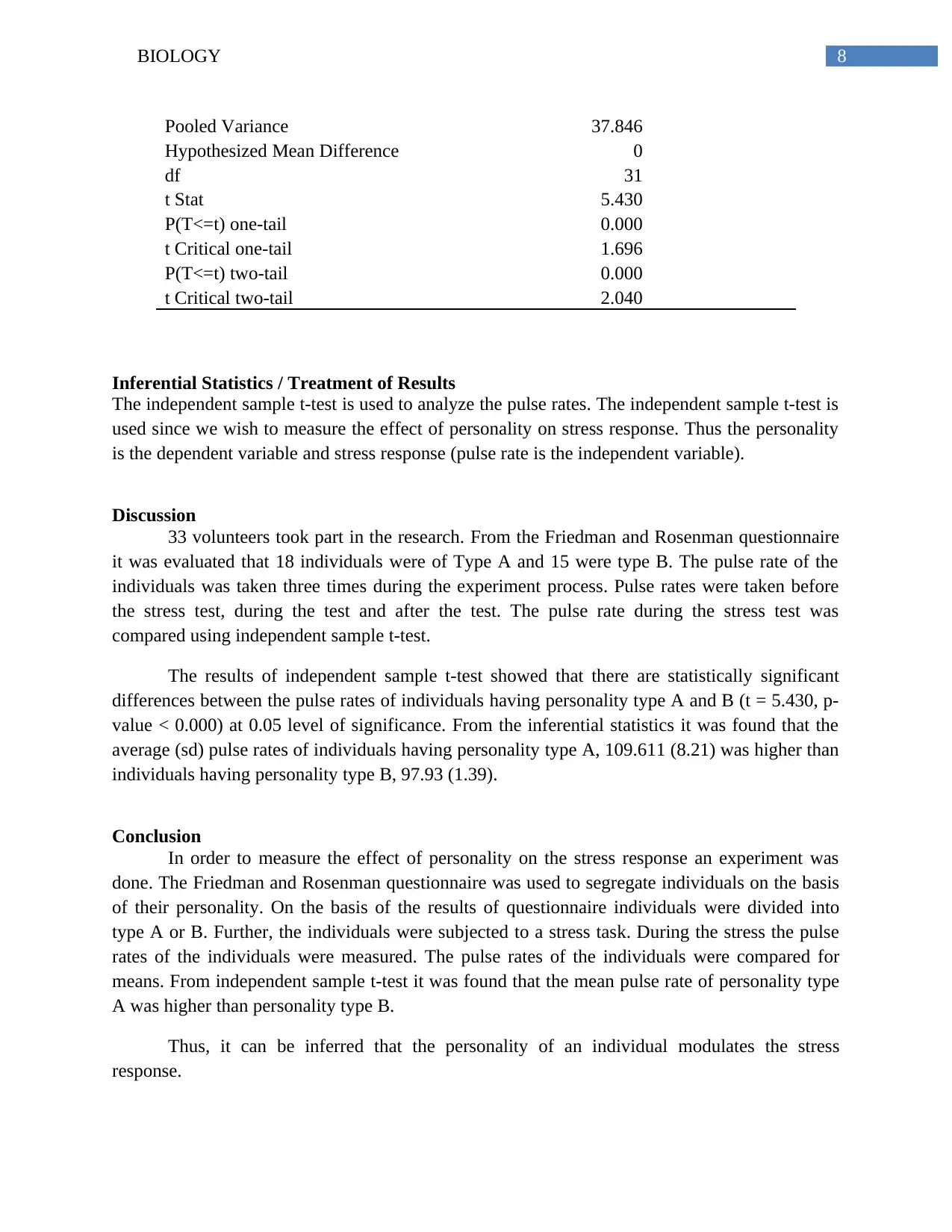
8BIOLOGY
Pooled Variance 37.846
Hypothesized Mean Difference 0
df 31
t Stat 5.430
P(T<=t) one-tail 0.000
t Critical one-tail 1.696
P(T<=t) two-tail 0.000
t Critical two-tail 2.040
Inferential Statistics / Treatment of Results
The independent sample t-test is used to analyze the pulse rates. The independent sample t-test is
used since we wish to measure the effect of personality on stress response. Thus the personality
is the dependent variable and stress response (pulse rate is the independent variable).
Discussion
33 volunteers took part in the research. From the Friedman and Rosenman questionnaire
it was evaluated that 18 individuals were of Type A and 15 were type B. The pulse rate of the
individuals was taken three times during the experiment process. Pulse rates were taken before
the stress test, during the test and after the test. The pulse rate during the stress test was
compared using independent sample t-test.
The results of independent sample t-test showed that there are statistically significant
differences between the pulse rates of individuals having personality type A and B (t = 5.430, p-
value < 0.000) at 0.05 level of significance. From the inferential statistics it was found that the
average (sd) pulse rates of individuals having personality type A, 109.611 (8.21) was higher than
individuals having personality type B, 97.93 (1.39).
Conclusion
In order to measure the effect of personality on the stress response an experiment was
done. The Friedman and Rosenman questionnaire was used to segregate individuals on the basis
of their personality. On the basis of the results of questionnaire individuals were divided into
type A or B. Further, the individuals were subjected to a stress task. During the stress the pulse
rates of the individuals were measured. The pulse rates of the individuals were compared for
means. From independent sample t-test it was found that the mean pulse rate of personality type
A was higher than personality type B.
Thus, it can be inferred that the personality of an individual modulates the stress
response.
Pooled Variance 37.846
Hypothesized Mean Difference 0
df 31
t Stat 5.430
P(T<=t) one-tail 0.000
t Critical one-tail 1.696
P(T<=t) two-tail 0.000
t Critical two-tail 2.040
Inferential Statistics / Treatment of Results
The independent sample t-test is used to analyze the pulse rates. The independent sample t-test is
used since we wish to measure the effect of personality on stress response. Thus the personality
is the dependent variable and stress response (pulse rate is the independent variable).
Discussion
33 volunteers took part in the research. From the Friedman and Rosenman questionnaire
it was evaluated that 18 individuals were of Type A and 15 were type B. The pulse rate of the
individuals was taken three times during the experiment process. Pulse rates were taken before
the stress test, during the test and after the test. The pulse rate during the stress test was
compared using independent sample t-test.
The results of independent sample t-test showed that there are statistically significant
differences between the pulse rates of individuals having personality type A and B (t = 5.430, p-
value < 0.000) at 0.05 level of significance. From the inferential statistics it was found that the
average (sd) pulse rates of individuals having personality type A, 109.611 (8.21) was higher than
individuals having personality type B, 97.93 (1.39).
Conclusion
In order to measure the effect of personality on the stress response an experiment was
done. The Friedman and Rosenman questionnaire was used to segregate individuals on the basis
of their personality. On the basis of the results of questionnaire individuals were divided into
type A or B. Further, the individuals were subjected to a stress task. During the stress the pulse
rates of the individuals were measured. The pulse rates of the individuals were compared for
means. From independent sample t-test it was found that the mean pulse rate of personality type
A was higher than personality type B.
Thus, it can be inferred that the personality of an individual modulates the stress
response.
⊘ This is a preview!⊘
Do you want full access?
Subscribe today to unlock all pages.

Trusted by 1+ million students worldwide
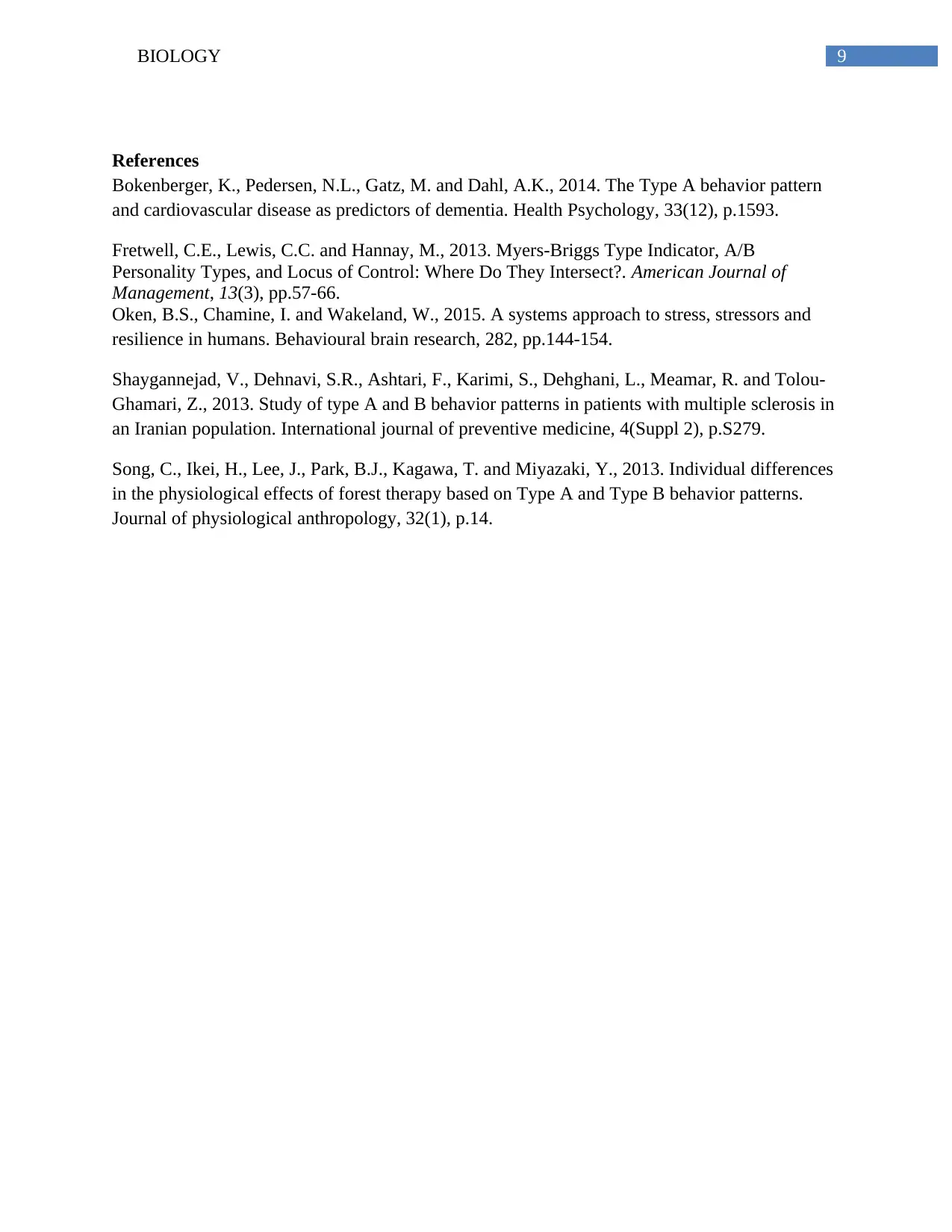
9BIOLOGY
References
Bokenberger, K., Pedersen, N.L., Gatz, M. and Dahl, A.K., 2014. The Type A behavior pattern
and cardiovascular disease as predictors of dementia. Health Psychology, 33(12), p.1593.
Fretwell, C.E., Lewis, C.C. and Hannay, M., 2013. Myers-Briggs Type Indicator, A/B
Personality Types, and Locus of Control: Where Do They Intersect?. American Journal of
Management, 13(3), pp.57-66.
Oken, B.S., Chamine, I. and Wakeland, W., 2015. A systems approach to stress, stressors and
resilience in humans. Behavioural brain research, 282, pp.144-154.
Shaygannejad, V., Dehnavi, S.R., Ashtari, F., Karimi, S., Dehghani, L., Meamar, R. and Tolou-
Ghamari, Z., 2013. Study of type A and B behavior patterns in patients with multiple sclerosis in
an Iranian population. International journal of preventive medicine, 4(Suppl 2), p.S279.
Song, C., Ikei, H., Lee, J., Park, B.J., Kagawa, T. and Miyazaki, Y., 2013. Individual differences
in the physiological effects of forest therapy based on Type A and Type B behavior patterns.
Journal of physiological anthropology, 32(1), p.14.
References
Bokenberger, K., Pedersen, N.L., Gatz, M. and Dahl, A.K., 2014. The Type A behavior pattern
and cardiovascular disease as predictors of dementia. Health Psychology, 33(12), p.1593.
Fretwell, C.E., Lewis, C.C. and Hannay, M., 2013. Myers-Briggs Type Indicator, A/B
Personality Types, and Locus of Control: Where Do They Intersect?. American Journal of
Management, 13(3), pp.57-66.
Oken, B.S., Chamine, I. and Wakeland, W., 2015. A systems approach to stress, stressors and
resilience in humans. Behavioural brain research, 282, pp.144-154.
Shaygannejad, V., Dehnavi, S.R., Ashtari, F., Karimi, S., Dehghani, L., Meamar, R. and Tolou-
Ghamari, Z., 2013. Study of type A and B behavior patterns in patients with multiple sclerosis in
an Iranian population. International journal of preventive medicine, 4(Suppl 2), p.S279.
Song, C., Ikei, H., Lee, J., Park, B.J., Kagawa, T. and Miyazaki, Y., 2013. Individual differences
in the physiological effects of forest therapy based on Type A and Type B behavior patterns.
Journal of physiological anthropology, 32(1), p.14.
Paraphrase This Document
Need a fresh take? Get an instant paraphrase of this document with our AI Paraphraser
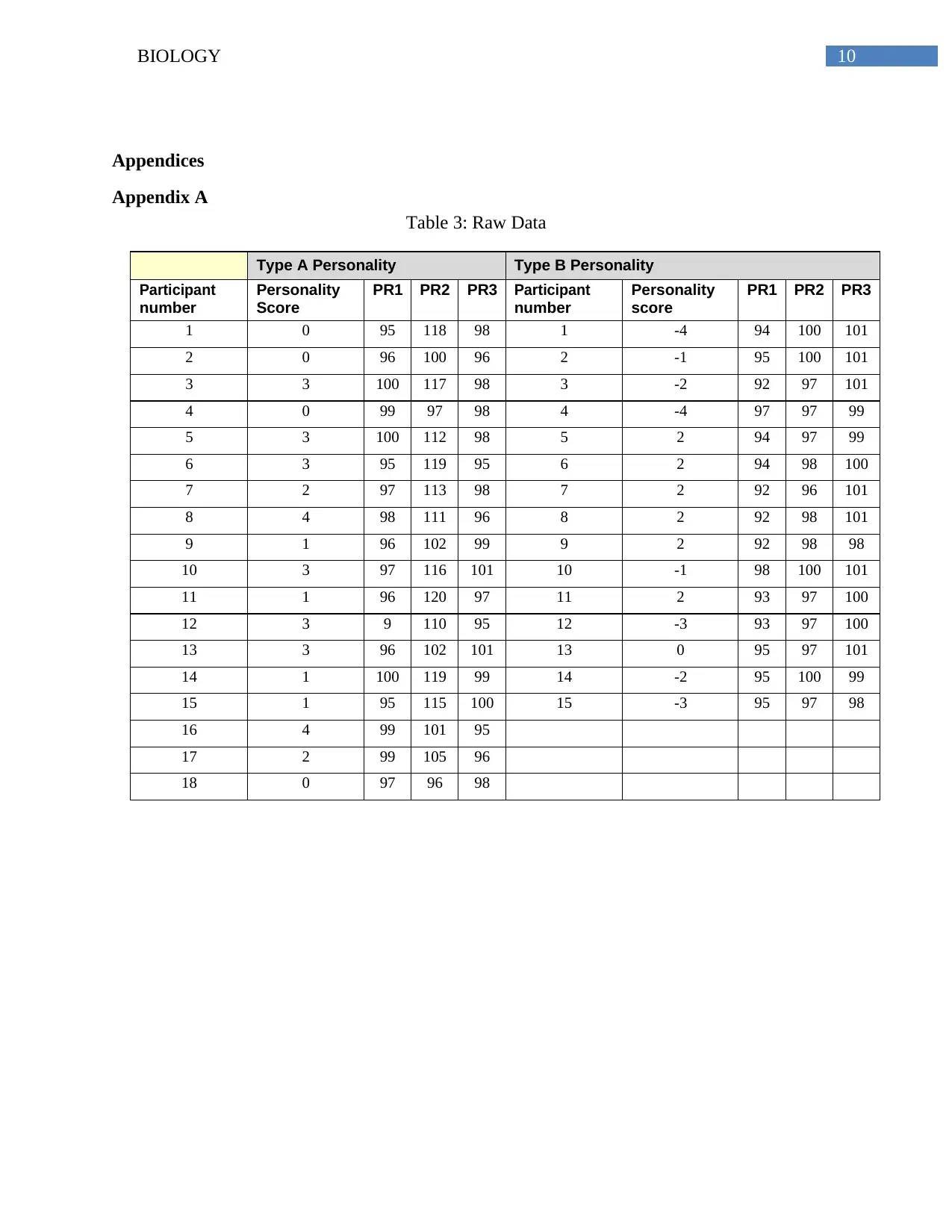
10BIOLOGY
Appendices
Appendix A
Table 3: Raw Data
Type A Personality Type B Personality
Participant
number
Personality
Score
PR1 PR2 PR3 Participant
number
Personality
score
PR1 PR2 PR3
1 0 95 118 98 1 -4 94 100 101
2 0 96 100 96 2 -1 95 100 101
3 3 100 117 98 3 -2 92 97 101
4 0 99 97 98 4 -4 97 97 99
5 3 100 112 98 5 2 94 97 99
6 3 95 119 95 6 2 94 98 100
7 2 97 113 98 7 2 92 96 101
8 4 98 111 96 8 2 92 98 101
9 1 96 102 99 9 2 92 98 98
10 3 97 116 101 10 -1 98 100 101
11 1 96 120 97 11 2 93 97 100
12 3 9 110 95 12 -3 93 97 100
13 3 96 102 101 13 0 95 97 101
14 1 100 119 99 14 -2 95 100 99
15 1 95 115 100 15 -3 95 97 98
16 4 99 101 95
17 2 99 105 96
18 0 97 96 98
Appendices
Appendix A
Table 3: Raw Data
Type A Personality Type B Personality
Participant
number
Personality
Score
PR1 PR2 PR3 Participant
number
Personality
score
PR1 PR2 PR3
1 0 95 118 98 1 -4 94 100 101
2 0 96 100 96 2 -1 95 100 101
3 3 100 117 98 3 -2 92 97 101
4 0 99 97 98 4 -4 97 97 99
5 3 100 112 98 5 2 94 97 99
6 3 95 119 95 6 2 94 98 100
7 2 97 113 98 7 2 92 96 101
8 4 98 111 96 8 2 92 98 101
9 1 96 102 99 9 2 92 98 98
10 3 97 116 101 10 -1 98 100 101
11 1 96 120 97 11 2 93 97 100
12 3 9 110 95 12 -3 93 97 100
13 3 96 102 101 13 0 95 97 101
14 1 100 119 99 14 -2 95 100 99
15 1 95 115 100 15 -3 95 97 98
16 4 99 101 95
17 2 99 105 96
18 0 97 96 98
1 out of 11
Related Documents
Your All-in-One AI-Powered Toolkit for Academic Success.
+13062052269
info@desklib.com
Available 24*7 on WhatsApp / Email
![[object Object]](/_next/static/media/star-bottom.7253800d.svg)
Unlock your academic potential
Copyright © 2020–2025 A2Z Services. All Rights Reserved. Developed and managed by ZUCOL.





